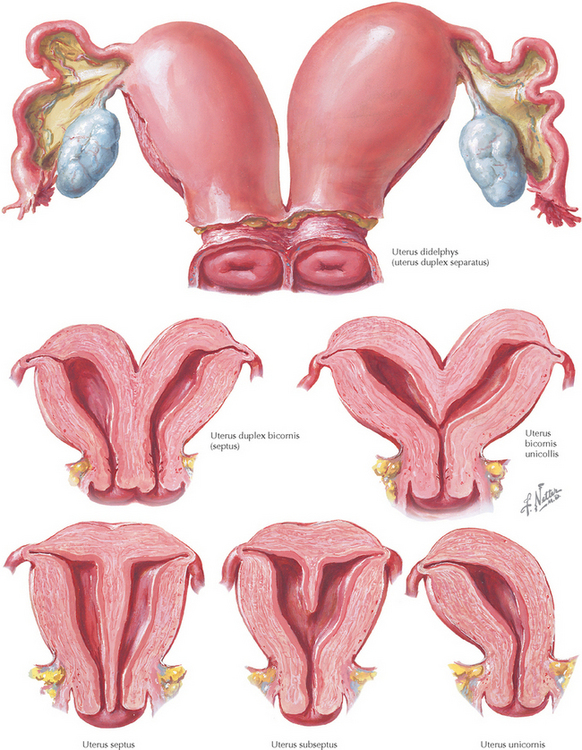Chapter 120 Uterine Anomalies: Bicornuate, Septate, and Unicornuate Uterus
INTRODUCTION
ETIOLOGY AND PATHOGENESIS
CLINICAL CHARACTERISTICS
DIAGNOSTIC APPROACH
MANAGEMENT AND THERAPY
Nonpharmacologic
FOLLOW-UP
MISCELLANEOUS
Lin PC. Reproductive outcomes in women with uterine anomalies. J Womens Health (Larchmt). 2004;13:33.
Moutos DM, Damewood MD, Schlaff WD, Rock JA. A comparison of the reproductive outcome between women with a unicornuate uterus and women with a didelphic uterus. Fertil Steril. 1992;58:88.
Reinhold C, Hricak H, Forstner R, et al. Primary amenorrhea: evaluation with MR imaging. Radiology. 1997;203:383.
Rock JA, Jones HJ. The double uterus associated with an obstructed hemivagina and ipsilateral renal agenesis. Am J Obstet Gynecol. 1980;138:339.
Toaff ME, Lev-Toaff AS, Toaff R. Communicating uteri: review and classification with introduction of two previously unrecorded types. Fertil Steril. 1984;41:661.
Buttram VC. Müllerian anomalies and their management. Fertil Steril. 1983;40:159.
Doyle MB. Magnetic resonance imaging in mullerian fusion defects. J Reprod Med. 1992;37:33.
Golan A, Langer R, Bukovsky I, Caspi E. Congenital anomalies of the mullerian system. Fertil Steril. 1989;51:747.
Grimbizis GF, Camus M, Tarlatzis BC, et al. Clinical implications of uterine malformations and hysteroscopic treatment results. Hum Reprod Update. 2001;7:161.
Hay D. Uterus unicornis and its relationship to pregnancy. J Obstet Gynecol Br Emp. 1961;68:371.
Jayasinghe Y, Rane A, Stalewski H, Grover S. The presentation and early diagnosis of the rudimentary uterine horn. Obstet Gynecol. 2005;105:1456.
Jones HW. Reproductive impairment and the malformed uterus. Fertil Steril. 1981;36:137.
Katz VL, Lentz GM. Congenital abnormalities of the female reproductive tract. In: Katz VL, Lentz GM, Lobo RA, Gershenson DM, editors. Comprehensive Gynecology. 5th ed. Philadelphia: Mosby/Elsevier; 2007:250.
Markham SM, Waterhouse TB. Structural anomalies of the reproductive tract. Curr Opin Obstet Gynecol. 1992;4:867.
Mayo-Smith WW, Lee MJ. MR imaging of the female pelvis. Clin Radiol. 1995;50:667.
Nahum GG. Uterine anomalies. How common are they, and what is their distribution among subtypes? J Reprod Med. 1998;43:877.
Pinsonneault O, Goldstein DP. Obstructing malformations of the uterus and vagina. Fertil Steril. 1985;44:241.
Woodward PJ, Sohaey R, Wagner BJ. Congenital uterine malformations. Curr Probl Diagn Radiol. 1995;24:178.
Woodward PJ, Wagner BJ, Farley TE. MR imaging in the evaluation of female infertility. Radiographics. 1993;13:293.








